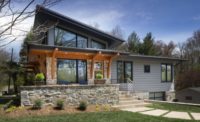Once you have built affordable housing, how can you make sure it stays affordable? One tried-and-true solution is to design for energy-efficiency and durability in ways that reduce maintenance and operating costs. And "green building" strategies and methods like these are good for the planet, too.
Design and master planning firm The Architectural Team is an industry leader in creating super-energy-efficient affordable housing complexes, adhering to strict voluntary energy standards and often integrating systems like photovoltaic solar power. The firm's work on multifamily projects for lower and mixed income populations typically includes sustainable, durable and energy-efficient elements.
Recent successes have included solar energy systems that help to reduce electric bills for owners and residents alike, and building construction that meets the super-strict Passive House energy-efficiency standard.
"These strategies make affordable housing green and clean," says Jay Szymanski, associate with The Architectural Team. "At the same time, they can reduce living expenses for residents and operating costs for owners."
Some recent examples of the firm's work are detailed below.
The Homes at Old Colony, South Boston, MA
For the nation's oldest federal public housing, The Architectural Team was tapped to completely revamp the entire South Boston neighborhood. Barracks-style housing was demolished and a new, more open and friendly master plan was established. The majority of the structures at The Homes at Old Colony received Platinum certification under the USGBC's LEED for Homes standard, while also meeting EPA Energy Star criteria and HUD Healthy Homes guidelines. The firm also helped arrange a partnership with a third-party energy company, which installed photovoltaic systems on every new building. "The buildings are oriented to maximize solar exposure, with carefully designed exterior envelopes that significantly reduce heating and air-conditioning loads," says Szymanski.
Most recently, The Homes at Old Colony was awarded Gold certification under the new LEED for Neighborhood Development standard. "LEED-ND certification was a goal from the very beginning of the Homes at Old Colony project," says Szymanski. "The new master plan connects the neighborhood physically and visually to the surrounding area, including the neighboring public park and beach as well as public transit. The new streets are tree-lined and shady, and pedestrian-friendly thanks to safer traffic patterns."
Other green features in the re-imagined public housing include:
- Permeable concrete pavers
- Water-saving irrigation systems
- Low-flow plumbing fixtures
- High-performance hot-water pipe insulation, and
- Non-HCFC refrigerants
"Making a project highly sustainable, durable and energy-efficient while staying within budget can be challenging," says Szymanski. "But the long-term benefits are undeniable. For affordable housing, integrating a renewable energy system like solar, wind, or hydro is a win-win."
Ellen S. Jackson Apartments, Roxbury, MA
Named after a noted local civil rights leader the Ellen S. Jackson Apartments in Roxbury, Mass. offers seniors affordable independent living with a range of amenities, including a library, a roof terrace, and a garden. Nationally recognized leaders in the design of housing for seniors, The Architectural Team designed the apartments to target LEED Gold certification--and may achieve Platinum, ultimately.
The design combines 138 solar panels (33 kiloWatts total, powering lighting and more for common areas) with a rooftop solar hot-water system. Together these systems greatly reduce energy consumption and operating costs, benefitting the owner, not-for-profit Nuestra Comunidad Development Corporation. The apartments also boast a 2,000-gallon rainwater harvesting cistern for irrigation, and all flooring is carpet-free, contributing to improved indoor air quality (IAQ).
Bristol Commons & Lenox Green, Taunton, MA
With infrastructure, utilities, and building components badly out of date, the 150-unit public housing complex formerly known as Fairfax Gardens was in need of a complete tear-down and replacement. As with Old Colony, The Architectural Team created a new, less isolating master plan to situate 88 New England-style town-home and duplex units, plus another 72 units on an adjacent site. But the project's master stroke was in the energy-efficient design.
By employing the Passive House model of design developed in Germany, The Architectural Team delivered a project whose owner anticipates world-class energy savings—as much as 90 percent less than a typical house. Renamed Bristol Commons (and adjacent Lenox Green) the project’s high-performance building envelopes include meticulous air sealing at joints and hairline cracks while the twelve-inch-thick walls and triple-pane windows offer exceptional insulation. Tightly sealed, the redesigned public housing uses mechanical ventilation to bring in fresh air, which coupled with optimal building orientation results in extremely high energy efficiency—and low utility bills.







